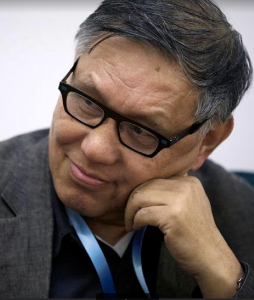Presented By: Lieberthal-Rogel Center for Chinese Studies
LRCCS Noon Lecture Series | Retelling the Story of Dunhuang Buddhist Art: A Spatial Approach
Wu Hung, Harrie A. Vanderstappen Distinguished Service Professorship in Chinese Art History, University of Chicago

Attend in person or via Zoom. Zoom registration at https://myumi.ch/bykee
This lecture retells the story of Dunhuang art through the perspective of space. Although there are countless overviews of the art of Dunhuang, the framework is generally temporal. Guided by the dynasties of China’s past, these overviews present a linear history of the Mogao Caves, supplanting the actual place with an abstract temporal sequence. This lecture presents an alternative narrative based on visitors’ experience and discusses some representative caves to demonstrate a new methodology in studying Dunhuang art Mogao.
Wu Hung holds the Harrie A. Vanderstappen Distinguished Service Professorship at the Department of Art History and the Department of East Asian Languages and Civilizations at the University of Chicago, and is also the director of the Center for the Art of East Asia at the same university. An elected member of the American Academy of Art and Science and the American Philosophic Society, he has received many awards for his publications and academic services, including the Distinguished Teaching Award (2008) and Distinguished Scholar Award (2018) from the College of Art Association (CAA), an Honorary Degree in Arts from Harvard University (2019), and the Distinguished Lifetime Achievement Award for Writing on Art from CAA (2022). Wu Hung’s research interests include both traditional and contemporary Chinese art, and he has published many books and curated many exhibitions in these two fields. His interdisciplinary interest has led him to experiment with different ways to tell stories about Chinese art, as exemplified by his "Monumentality in Early Chinese Art and Architecture" (1995), "The Double Screen: Medium and Representation of Chinese Pictorial Art" (1996), "Remaking Beijing: Tiananmen Square: the Creation of a Political Space" (2005), "The Art of the Yellow Springs: Understanding Chinese Tombs" (2010), "A Story of Ruins: Presence and Absence in Chinese Art and Visual Culture" (2012), "Zooming In: Histories of Photography in China" (2016), and "Space in Art History" (2018). His three newest books from 2022 and 2023 include "Chinese and Dynastic Time" (Princeton University Press), "Spatial Dunhuang: Experiencing the Mogao Caves" (Washington University Press), and "The Full Length Mirror: A Global Visual History" (Reaktion Books).
If there is anything we can do to make this event accessible to you, please contact us. Please be aware that advance notice is necessary as some accommodations may require more time for the university to arrange.
This lecture retells the story of Dunhuang art through the perspective of space. Although there are countless overviews of the art of Dunhuang, the framework is generally temporal. Guided by the dynasties of China’s past, these overviews present a linear history of the Mogao Caves, supplanting the actual place with an abstract temporal sequence. This lecture presents an alternative narrative based on visitors’ experience and discusses some representative caves to demonstrate a new methodology in studying Dunhuang art Mogao.
Wu Hung holds the Harrie A. Vanderstappen Distinguished Service Professorship at the Department of Art History and the Department of East Asian Languages and Civilizations at the University of Chicago, and is also the director of the Center for the Art of East Asia at the same university. An elected member of the American Academy of Art and Science and the American Philosophic Society, he has received many awards for his publications and academic services, including the Distinguished Teaching Award (2008) and Distinguished Scholar Award (2018) from the College of Art Association (CAA), an Honorary Degree in Arts from Harvard University (2019), and the Distinguished Lifetime Achievement Award for Writing on Art from CAA (2022). Wu Hung’s research interests include both traditional and contemporary Chinese art, and he has published many books and curated many exhibitions in these two fields. His interdisciplinary interest has led him to experiment with different ways to tell stories about Chinese art, as exemplified by his "Monumentality in Early Chinese Art and Architecture" (1995), "The Double Screen: Medium and Representation of Chinese Pictorial Art" (1996), "Remaking Beijing: Tiananmen Square: the Creation of a Political Space" (2005), "The Art of the Yellow Springs: Understanding Chinese Tombs" (2010), "A Story of Ruins: Presence and Absence in Chinese Art and Visual Culture" (2012), "Zooming In: Histories of Photography in China" (2016), and "Space in Art History" (2018). His three newest books from 2022 and 2023 include "Chinese and Dynastic Time" (Princeton University Press), "Spatial Dunhuang: Experiencing the Mogao Caves" (Washington University Press), and "The Full Length Mirror: A Global Visual History" (Reaktion Books).
If there is anything we can do to make this event accessible to you, please contact us. Please be aware that advance notice is necessary as some accommodations may require more time for the university to arrange.